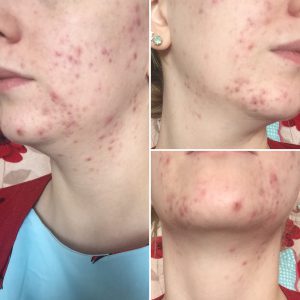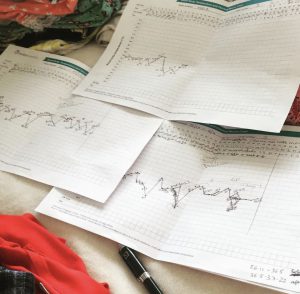I started tracking my basal body temperature (BBT) a few years ago, after being told the cause for my acne, migraines and irregular periods was something called “oestrogen dominance”.

The cystic acne was really painful.
However, tracking your BBT may also indicate whether you are hypothyroid or under / over medicated, as having hypothyroidism can change the way body heat is generated and maintained, too. There can be multiple benefits to learning about tracking BBT.
What is BBT?
Your BBT (basal body temperature) is the temperature of your body at rest and your lowest temperature of the day. Thyroid hormones are important for maintaining a consistent BBT and if your thyroid hormone levels become too low, your BBT can also drop. This may cause you to feel more tired and cold as a result.
However, information collected from BBT tracking should always be used alongside thyroid blood test results and not relied on alone for managing thyroid conditions and medication dosages.
For menstruating people, a temperature between 36.1°C and 36.5°C is considered normal for the first half of their cycle, and between 36.5°C and 37.22°C in the second half. Lower than these and you may be undermedicated / it can indicate hypothyroidism. Tracking your BBT for at least a month, though preferably a few months will help you pinpoint your own ‘normal’.
Some thyroid sources will say that a temperature between 36.5°C and 36.7°C is ‘normal’ and anything lower indicates hypothyroidism, but as you can see from the information above, if you experience menstruation then your temperature can differ wildly throughout the month, so this needs to be factored in also.
Why I Found Tracking BBT Useful
Tracking my BBT whilst working on resolving what my functional medicine practitioner referred to as “oestrogen dominance” let me see the change in my hormones alongside physical symptoms also resolving (ongoing fatigue, migraines, cystic acne, irregular periods, gut issues and sleep issues).
As these issues resolved and my irregular periods with no sign of ovulation gradually became more regular and ovulation became predictable, my BBT also reflected a more ‘normal’ or typical cycle. It was reassuring to see the BBT tracking reflect how I was physically feeling.
Tracking my BBT meant that I became really in tune with my hormones and cycles which helped me understand my body so much better. I knew when I was in the oestrogen dominant part of my cycle and progesterone dominant part, but also when I was ovulating and when my period was going to start, all by becoming familiar with my BBT.
This came in handy a couple years later when trying for a baby as I fell pregnant straight away with help from the information my BBT was giving me; when my fertile days were.
It also helped me to recognise the signs my body gives when I’m ovulating or about to start my period, such as changes in cervical mucus, as well as changes to my BBT.
But mainly, tracking my BBT helped me to regulate my cycles and see where the problems were with my hormones. As the hormones balanced back out with my FMP’s guidance on resolving higher than normal oestrogen levels and high cortisol levels, my cycles regulated and became very predictable.
Here’s How You Can Take Your Own BBT:
🌡 Using a digital thermometer, take your temperature (usually under the tongue – follow your thermometer’s instructions) as soon as you wake up and before getting out of bed. It needs to be your resting temperature, before you’ve had time to be awake for long or move.
🌡 Record the temperature reading on a BBT chart when your thermometer indicates it has finished reading. These charts can easily be found online to print out or with BBT tracking phone apps. I started off using paper charts but moved to an app which was more convenient. I could plot my temperature each day and see it on a chart on my phone.
🌡 A temperature between 36.11°C and 36.5°C is typical in the first half of your cycle (the follicular phase) and between 36.5°C and 37.22°C in the second half (the luteal phase). This can help indicate which part of your cycle you are in.
🌡 A sudden temperature drop followed by a few days of higher readings (a “spike”) typically indicates ovulation. Ovulation usually happens around the middle of your cycle (e.g Day 14 on a 28 day cycle). However, this can differ from person to person and conditions such as PCOS can impact when you ovulate too.
🌡 The second half of your cycle (the luteal phase) should be at least 10-11 days long. If it isn’t it may indicate that you are oestrogen dominant. If you are, this can lead to the symptoms I mentioned at the start of this article. See information here on the theory of “oestrogen dominance”. It is quite debated.
Related Reading: 11 Things I Did to Optimise Conceiving With Hashimoto’s and Hypothyroidism
Let me know in the comments: Have you tried tracking your BBT?

The book Be Your Own Thyroid Advocate: When You’re Sick and Tired of Being Sick and Tired, which builds on this article in detail and covers the ways in which you can take control of your thyroid health and symptoms to live a healthier, more vibrant life.








No Comments